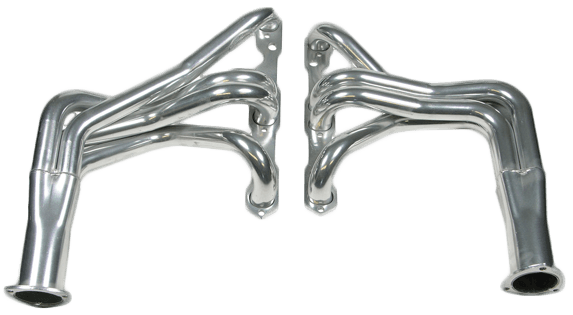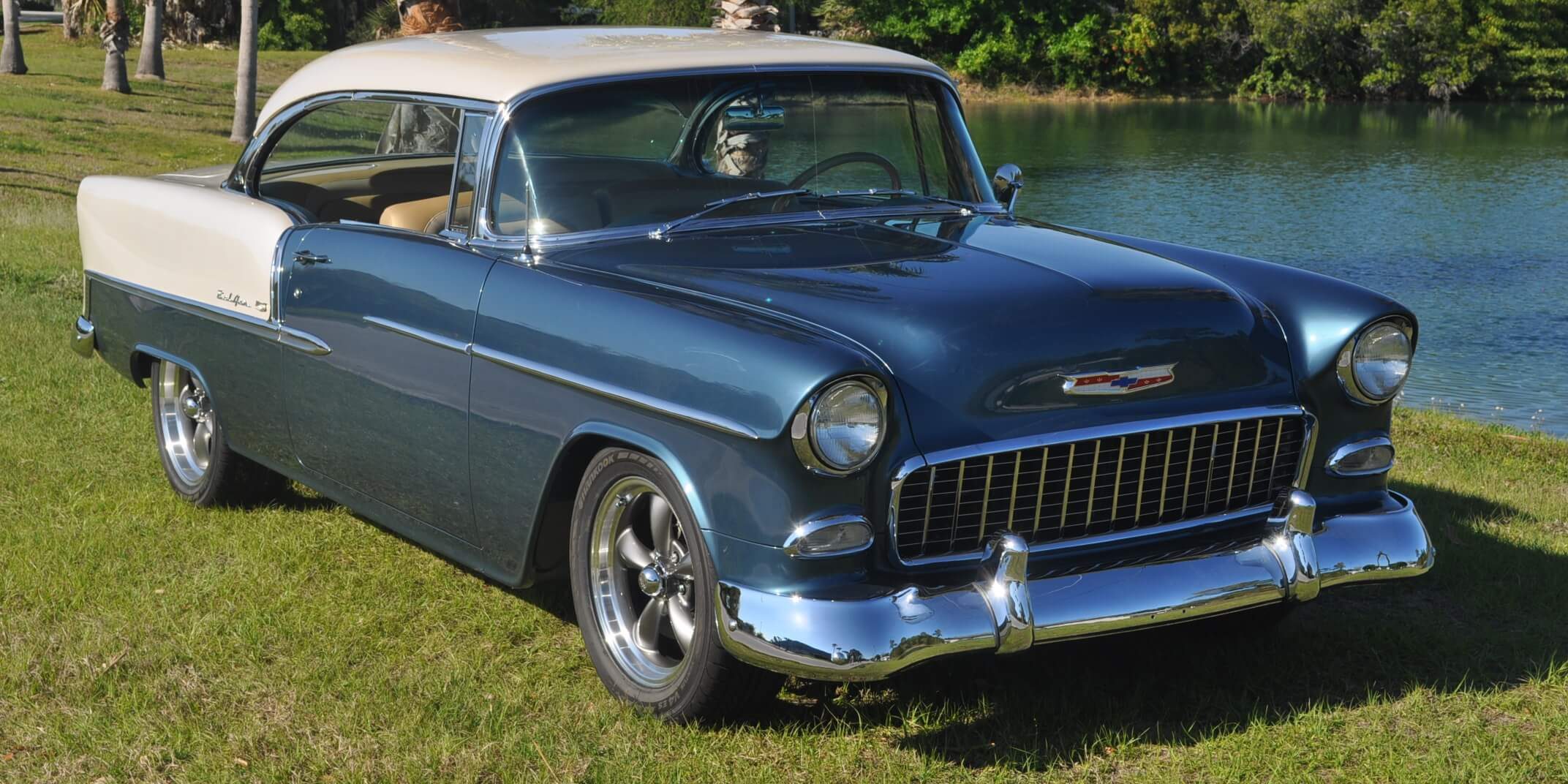Decisions, decisions. That’s what you’re faced with when building your ride. If it’s a restoration, many of your decisions have already been made for you. Such as interior, motor, wheels, paint color, etc. However, if you are building a custom or street rod, then you’re going to have to decide a lot of things on your own. But hey, that’s probably why you opted to build your own unique ride in the first place. It’s an opportunity to express yourself. Make a statement about what you like, and in a twisted sort of way, who you are. Now, as you know from my past columns, far be it from me to put the kibosh on creativity. Anybody’s taste can be tastefully done. What I want to suggest is a list of some of the more ordinary, functional decisions. An “either/or” kind of thing. So this month’s Top Ten List is about some of the more important decisions we all have to make when building that one of a kind ride.
- HEADERS OR STOCK MANIFOLDS? Now right off let me say I am no engine Guru.
 I have run headers and I have run stock exhaust manifolds. On the plus side of headers, they look cool and are reported to boost the horses up to 20%. The key here always seems to be quality. I’ve bought “top brand” headers that are just a nightmare to install. I can’t even imagine what a “cheap” set would have fit like! “They” (those who reportedly know way more than the rest of us) tell me that the engine runs cooler as an added benefit. I can’t say I’ve noticed a change in my Autometer temp gauge when I’ve installed headers. On the other hand there are stock exhaust manifolds, that while they fall short of a trick look, they always fit and clear all the necessary protrusions in the engine compartment and frame. One of the drawbacks to using the stock manifolds is they always seem really pitted. A condition that was seldom helped by a coat of high temp paint. However now there are several companies that will coat your exhaust system with a new type of material that is available in a variety of colors and is extremely durable. Another plus for the stock manifolds is you seldom have to replace exhaust gaskets, a ritual owners of header equipped vehicles are all too familiar with. An additional advantage of using stock manifolds is that you can run a stock exhaust system too. Which brings us to your next decision…
I have run headers and I have run stock exhaust manifolds. On the plus side of headers, they look cool and are reported to boost the horses up to 20%. The key here always seems to be quality. I’ve bought “top brand” headers that are just a nightmare to install. I can’t even imagine what a “cheap” set would have fit like! “They” (those who reportedly know way more than the rest of us) tell me that the engine runs cooler as an added benefit. I can’t say I’ve noticed a change in my Autometer temp gauge when I’ve installed headers. On the other hand there are stock exhaust manifolds, that while they fall short of a trick look, they always fit and clear all the necessary protrusions in the engine compartment and frame. One of the drawbacks to using the stock manifolds is they always seem really pitted. A condition that was seldom helped by a coat of high temp paint. However now there are several companies that will coat your exhaust system with a new type of material that is available in a variety of colors and is extremely durable. Another plus for the stock manifolds is you seldom have to replace exhaust gaskets, a ritual owners of header equipped vehicles are all too familiar with. An additional advantage of using stock manifolds is that you can run a stock exhaust system too. Which brings us to your next decision…
- STAINLESS OR ALUMINIZED EXHAUST? We all know the benefits of anything stainless. It simply doesn’t rust. Yet in the form of an exhaust system, it can be rather pricey. Still it is worth considering if you plan on keeping the vehicle any length of time. Most people I talk to don’t feel that it’s worth the extra cost since in their words, “I don’t drive the car that often, and when I do it’s usually not very far”. Unfortunately that scenario is a key reason to consider a stainless system. When taking into account the high humidity here in Florida, driving the vehicle short distances doesn’t allow the system to get hot enough to overcome condensation and “dry out”. Consequently, moisture stands in the pipes after the engine is shut off. And that can promote rust out. Yet, for most applications, I’ve seen aluminized pipes hold up for many years. Most muffler shop “chains” use aluminized pipe when bending up a stock exhaust system and if the car is a daily driver it is probably more than adequate. However, nothing will last like stainless. It’s without a doubt the last exhaust system you’ll put on your vehicle.
- VINYL OR LEATHER? Boy, there’s nothing like the smell of leather to exude luxury in the interior of a vehicle. But what about the cost? That’s probably what stops most people short when it comes to that decision. Yet, in my opinion, it’s not that leather costs so much, but rather that vinyl costs so little. I have purchased enough leather to do a typical 30’s or 40’s three-window coupe for less than $600. Now that includes the seating area, arm rests, door panels, and other miscellaneous sections (give or take). In addition you will need to buy matching vinyl for the nonessential areas. That should run about another $150. The equivalent in top quality vinyl to do the same job would be around $300. Now that is cheap and initially makes the choice to go with leather look like a lot. But the difference in this case is only $450. I know that isn’t chicken feed, but I’m just saying that in a vehicle you’re building for keeps, that’s not a whole pile of money to drop on the area of the vehicle you’ll be spending all YOUR time in. Of course you will still have to have someone actually “do” the interior, but that should be the same cost in either vinyl or leather (actually leather sews nicer). What do you spend on a set of tires and wheels that you only appreciate a few minutes each time you walk up to the vehicle? On the plus side for vinyl; it seldom if ever looses its color, is easily cleaned and requires virtually no attention. It will almost always look new without the character lines associated with aging leather.
- AUTO OR STICK? Grabbin’ gears is cool. It sounds great, and nothing puts you in touch with your ride like a run through the gears — for the first week or so. Then it becomes something you like less and less. If you’re like most people, the more you drive a stick around town in traffic, the more you begin to NOT want to drive a stick around town in traffic. Today’s automatics are almost trouble free, and with the availability of shift kits and stall converters you can build an automatic to do just what you want it to do. The four and five speed manual boxes are also fairly reliable but there’s the weak link called the clutch, pressure plate, and throw out bearing. Not to mention the clutch cable that always seems to break at the most inopportune time. Automatics used to be what Grandpa had in his car. Not anymore. They’re widely accepted in hot rod and street rod circles and have been in use on the dragstrip for years. Still there are a few of us that have a yearn to DRIVE! An itch that only a tee handle in the palm of your hand can scratch
- WINGS AND SCOOPS OR MOTOWN GENIE? Body modifications are as endless as the imagination. Indeed many owners suffer from an overactive imagination. Wild wings, huge hood scoops and lower body skirts abound at any car show. Yet, all too often these mods take away from the vehicle’s natural lines and take on a life of their own. Most all score high on the “wow” scale despite the fact that many times they are non-functional. Trying to create a different look to the same old body by attaining “more stuff” is usually a lot of work, a lot of drilling, and a lot of maintenance. On the other hand a clean flowing fender or quarter panel nicely painted can deliver a classic look that never goes out of style. Hood scoops made in fiberglass mated to steel hoods will crack. The forces at work while driving a vehicle with a huge wing create a multitude of stress problems concerning sheet metal, paint and bodywork.
- NARROWED REAR OR NOT? The look of a strip burner has never left us when building street vehicles. Wide tires gave way to wider tires. And wider tires gave way to way wider tires. All of which gave way to the narrowed rear. Now for sure I’ve seen cars that needed all that tire, but I’ve also seen my share of wanna be’s. Cars that are running a less than potent power plant with more tire than two motors would need. Narrowing the rear end is the easy part. Tubbing a rear is a lot of work. Tires are expensive, along with the 15″ x 15″ wheels necessary to mount them. The ride is out the window, and so is trunk space. If you are building that killer mega horsepower pro streeter – go for it. But if you are building a car to actually drive and enjoy, it just seems like a lot of work. Besides massive alterations such as that always seem to bring on a new set of headaches. Which leads us into your next decision…
- ROLL BARS AND CAGES, OR DRIVER FREEDOM AND A SHOULDER HARNESS? Speaking of headaches, try getting in and out of a vehicle with a full roll cage. Once again many of these are installed into vehicles that will never see the track or reach speeds at which a roll cage would be necessary. I’ll admit, it’s a look. But at what cost? I’ve seen people spend a lot of money on an interior that you can’t even appreciate because of the maze of tubing (as if a “real car” that actually needs a roll cage has any interior to speak of). Back to the driving thing. If you intend to drive and enjoy the vehicle I can assure you the “roll cage wriggle” you have to do every time you get in or out of the driver’s seat gets old real fast. If you drive a convertible I can accept the idea of at least a roll bar. Now that makes sense. But even still, do you really drive that fast and careless?
- PAINT AND PAINT SYSTEMS: Choosing paint is an important decision. There are several manufacturers of what essentially breaks down into the same categories of paint or paint systems. Once you have the vehicle ready; all the body work done, primed and set to go into the booth, the dollar amount that separates a really good paint system from inexpensive enamels is in my opinion negligible. There are single stage paints that are color and gloss all in one. And there are two stage paint systems that are a non-gloss polyester color basecoat that is topped with a clear gloss coat. Many single stage urethane systems are good and will last a fair amount of time. They have a hardener that is designed to be added to the paint. These paints MUST use a hardener and can not be successfully applied without it. Many of the lesser quality enamels will have an optional hardener. These paints are OK, but they tend to degenerate quickly in the form of color loss and oxidation. Of course the best quality paint system is the Basecoat/Clearcoat systems. The polyester basecoat color is sprayed and acts much like a lacquer. It dries fast and “lays out” nice and flat. Then the clearcoat is applied, usually 2 to 4 coats depending on the brand of clear used. Clearcoating ensures the utmost in color protection, high gloss and low maintenance. If you want the best, this is it.
- WHEELS AND TIRES: TRADITIONAL OR… Most cars we see have either 14 or 15 inch wheels. Some newer cars are coming equipped with 16 inch, and in rare cases 17 or 18 inch wheels. Some of the smallish SUV’s even have 18” or 20”. What that has done is made available aftermarket tires in these new 17 and 18 inch sizes. What’s more, now there’s even quite a selection of 20 inch diameter tires manufactured. In recent years there has been an explosion in custom wheel manufacturers. Where there were once only a handful now there are too many to name. So with all these choices what’s the way to go? In my opinion 14 inch wheels are straight out. 15’s are good, and best of all most common and therefore priced competitively. The larger 17 or 18 inch diameter wheels are a little more pricey but the tire availability is good and not too expensive. The larger diameter wheels are definitely in the exotic range and 20’s usually look a little out of place on a street rod– maybe on the back with 18’s up front. Both wheels and tires are up there in price, and your choice of size is limited. Yet it does give a neat look. However, be prepared to sacrifice ride comfort to the larger 18 inch wheels. As the wheel diameter grows the tire sidewall most times gets shorter resulting in a stiffer ride.
- I. OR GOOD OLD FASHIONED CARBS? Fuel injection is offered on many new cars and has been for many years. It provides the motor with a much leaner fuel mixture than a carburetor would. Contrary to popular belief, fuel injection became widely used on factory cars because of it’s fuel efficiency, not as a high performance modification. My own car got at least 5 miles more per gallon with the fuel injection system than it does with the Webber carbs. However, on the other hand, it picked up about 20 hp. It is true that a fuel injection unit can be tuned to run an engine to peak performance. It does however make the engine run hotter due to its leaner mixture. A carburetored engine usually runs a little rich and therefore a little cooler. Fuel atomization is not as fine as with F.I., but a carburetor can be less maintenance and more reliable. Most injection systems are computer controlled and therefore add one more possible point of failure into the system. If you like doing your own work on your engine, carbs are the way to go. Parts are readily available and inexpensive without the complications of an electronically controlled system. However I will admit the new FI bolt on systems are getting pretty attractive both in price and tune-ability.
In conclusion, let me say that I am in no way trying to criticize anyone’s vehicle or choices they have made in building their ride. I’m just saying that too often we make a decision that is impetuous without thinking about down the line a couple of months. We look at what everyone else is doing and it just seems like THE way to do it. Try and consider how well you will get along with the choices you are considering. You may be willing to tolerate the inconvenience of entry and exit through a roll cage, because that’s what you want. And that’s OK. Building the ride you want is what it’s all about. But remember it’s a lot of effort and a lot of hard earned cash. Most of us can only do it once. Most of us only want to do it once. So ride happy. Ride smart. And until next month keep salvagin’ and savin’, tunin’ and tinkerin’.


